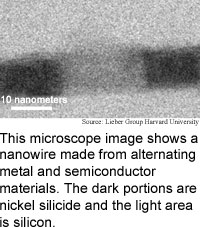
Hybrid nanowire makes transistor
One challenge in making minuscule electronic
devices from nanoscale components is wiring the components together.
Conventional lithography techniques cannot produce metal contacts
much smaller than 100 nanometers. These are an order of magnitude larger
than components made from nanowires and nanotubes. A nanometer is one
millionth of a millimeter, or the span of 10 hydrogen atoms.
Researchers from Harvard University have found a way to transform
sections of semiconducting silicon nanowires into metallic, or conducting,
nickel silicide. They used the process to produce hybrid semiconducting/metallic
nanowires. Regular semiconducting nanowires can be used as transistors.
The combination makes for a transistor complete with source and drain
electrode contacts.
Closely-spaced nanowire lattices could lead to ultra-dense memory
and logic circuits, according to the researchers.
The researchers used a perpendicular nanowire as a shadow mask
to make a hybrid nanowire with a particularly short semiconductor section.
The transistor's 20-nanometer long channel is comparable to the smallest
channel that is possible to make using today's state-of-the-art chip-making
techniques, according to the researchers.
The device's contact between semiconductor and wire is very precise
-- an atomically-defined junction between silicon and nickel silicide.
This will make for more consistent devices, and will also enable fundamental
physics studies of electrical flow in nanostructures with atomic-level
interfaces, according to the researchers.
The method could be used practically within a decade, according
to the researchers. The work appeared in the July 1, 2004 issue of Nature.
Selective shutdown protects nets
Tools design DNA-nanotube logic
Five photons linked
Liquid crystal IDs pathogens
Briefs:
Photosynthesis drives solar cell
Hybrid nanowire makes transistor
Nanocrystals spark efficient LEDs
Nanotubes make fluid filter
DNA copier uses little power
Method makes stronger steel

Research Watch blog
View from the High Ground Q&A
How It Works
RSS Feeds:
News
Ad links:
Buy an ad link
Ad links: Clear History
Buy an ad link
|
TRN
Newswire and Headline Feeds for Web sites
|
© Copyright Technology Research News, LLC 2000-2010. All rights reserved.